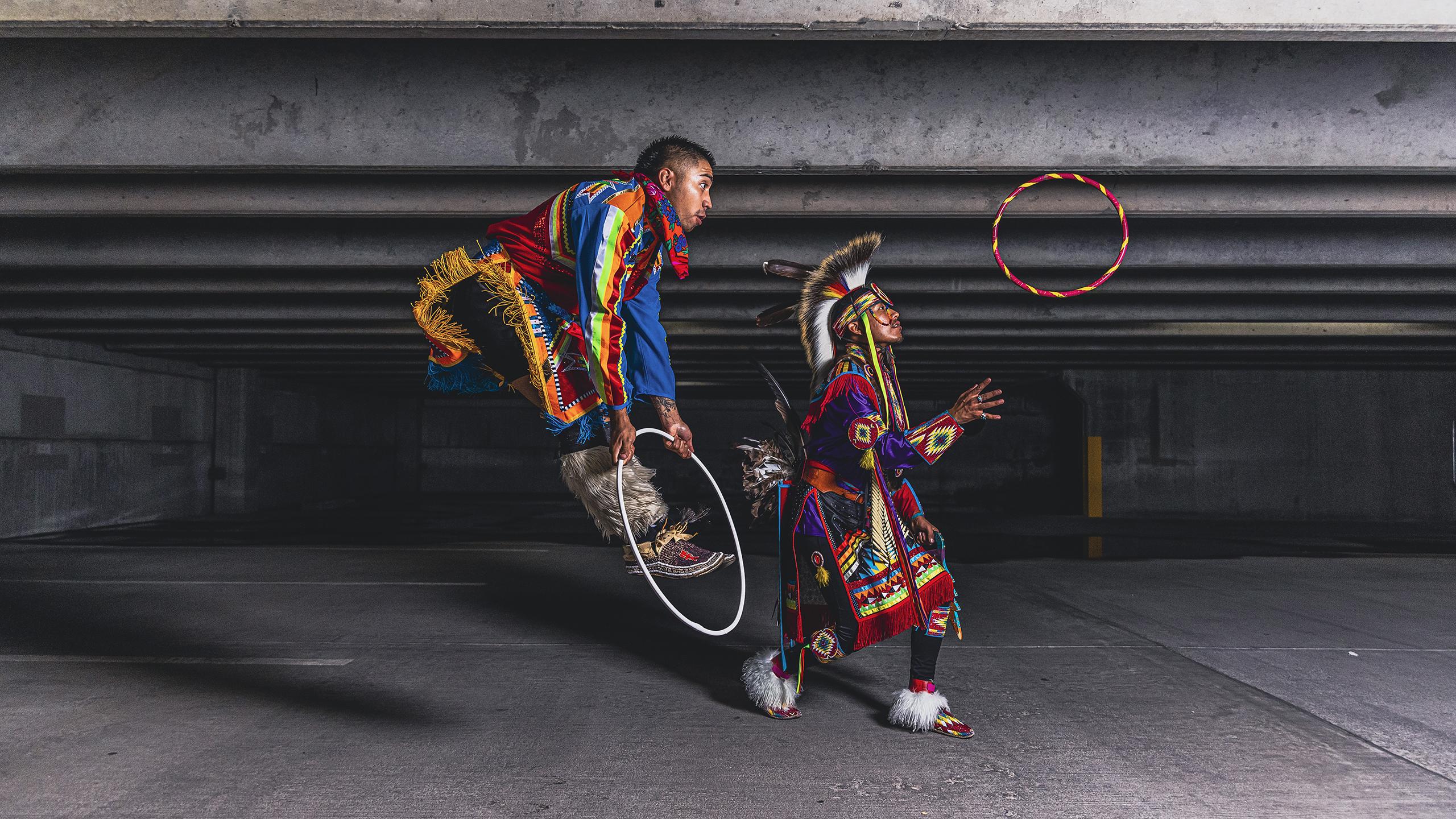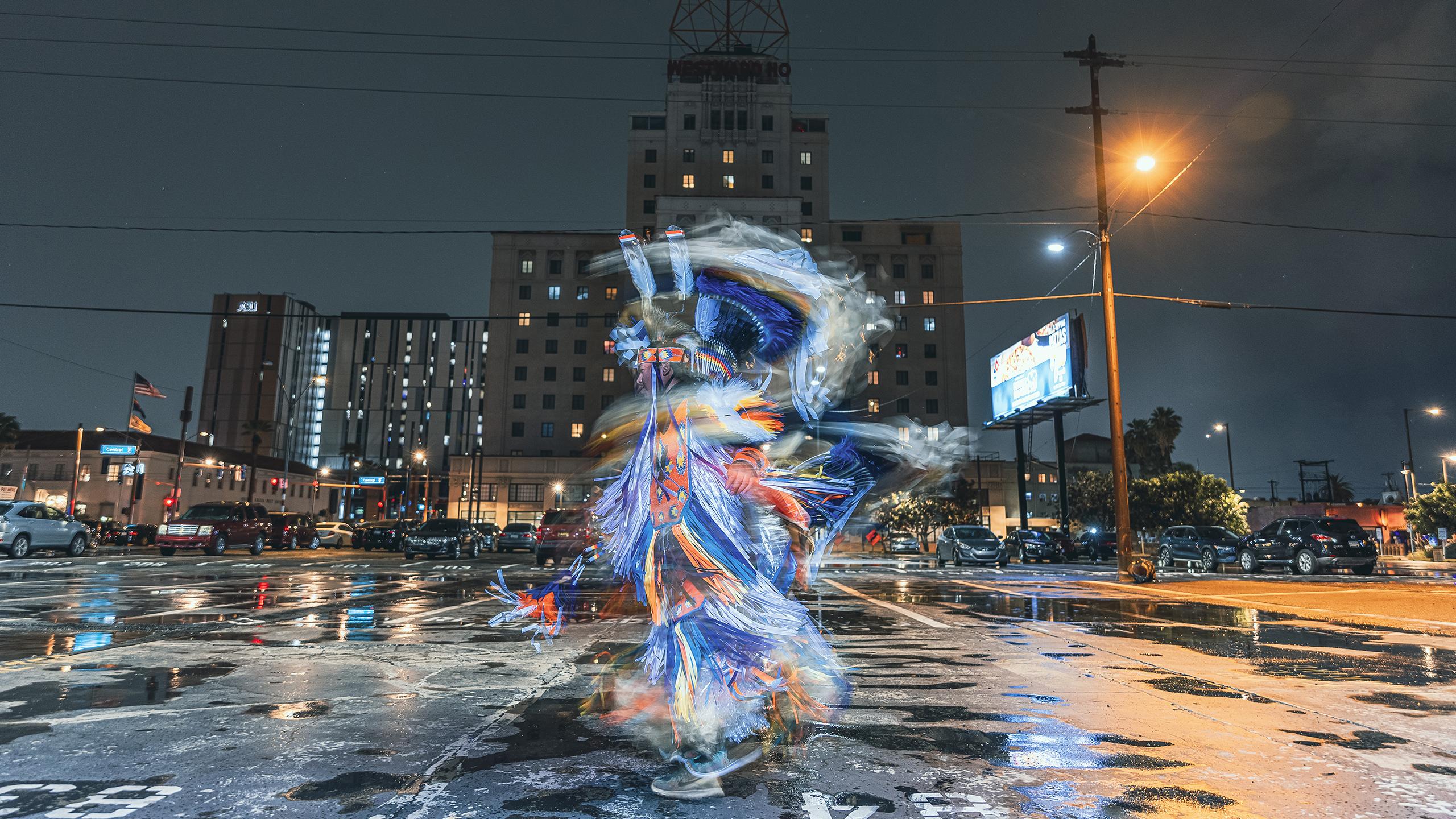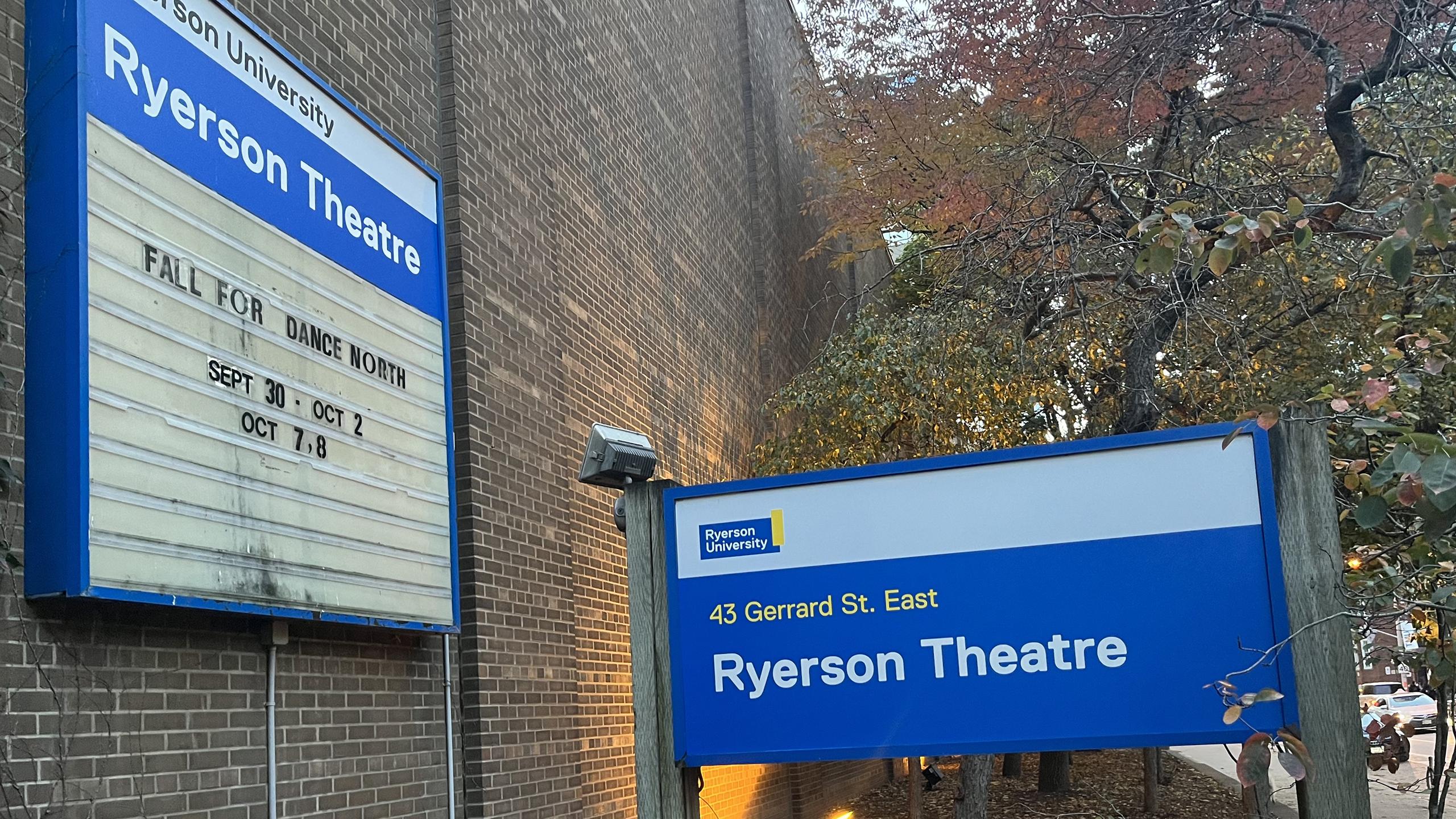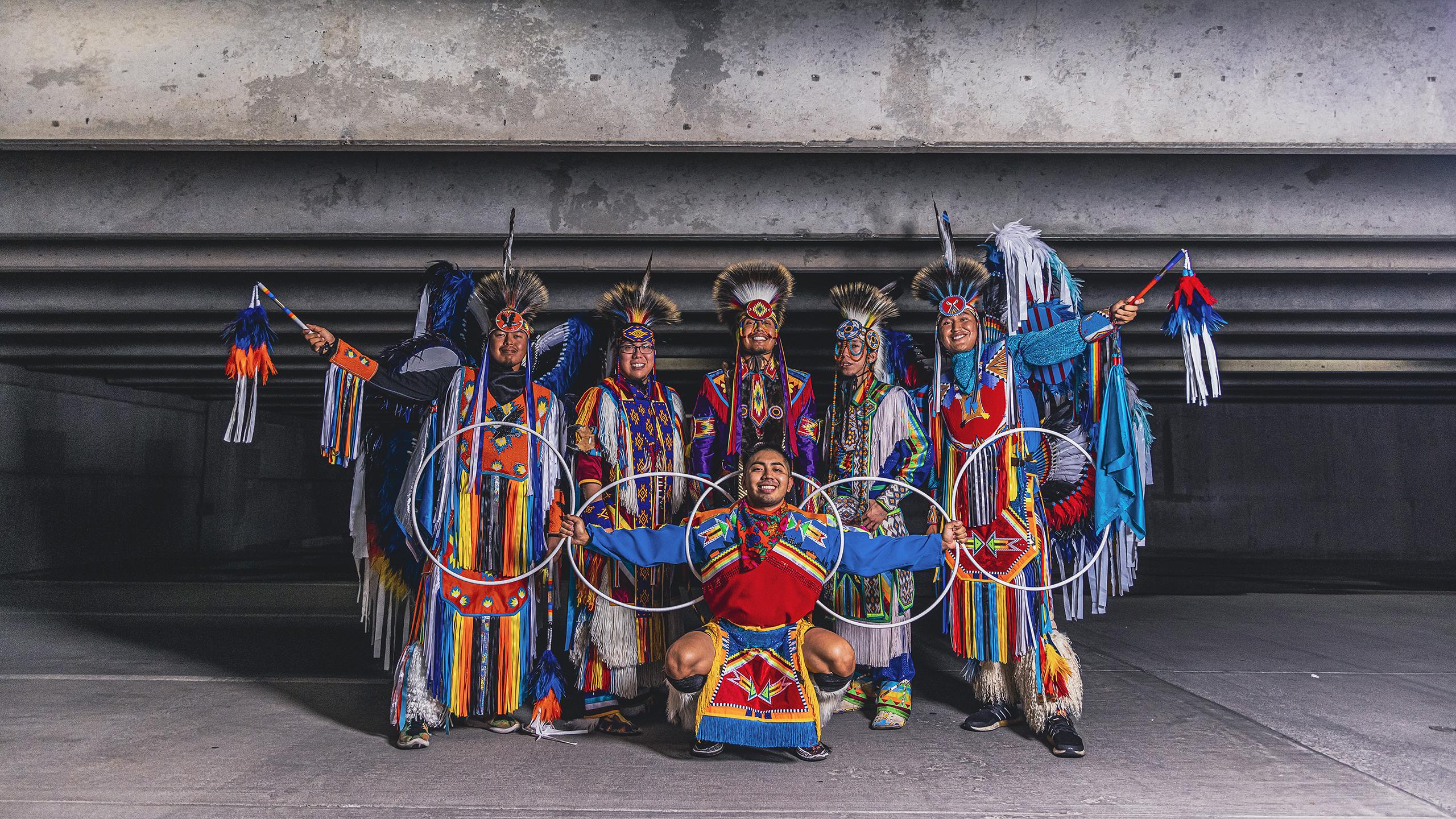By Maryam Azzam
Indigenous Enterprise, an Indigenous dance troupe from across Turtle Island, made their debut in the country at Toronto Metropolitan University (TMU), with their performance entitled Indigenous Liberation as part of the lineup for the eighth annual Fall For Dance North Festival.
Indigenous Enterprise is an Arizona-based intertribal dance troupe led and founded by Kenneth Shirley, a Diné Men’s Fancy War dancer, in 2015.
The performances, which took place at The Theatre at The Creative School on Oct. 7 and 8 explored an array of traditional dances and their origin stories through movement and filmmaking. Projected animations describing the histories of each dance set the stage for the incoming performer. The screen lit up with vibrant visuals to complement the dancers’ captivating performances and stunning regalia, while ensuring each dancer got their due spotlight.
Through movement and storytelling, the group seeks to educate the public on Indigeneity while simultaneously preserving and passing on traditional practices; an act of resistance against colonialism under systems that have historically aimed to suppress Indigenous people.


Indigenous Liberation began with a narrator providing context for the dances to come.
“Song and dance are universal and are a common thread that everyone connects to,” said the narrator. “Yet at one time our cultural dances and traditions and even our languages were stripped away from us and outlawed, taking away the very core of who we are as a people.”
One by one, the eight dancers took to the stage. The dancers’ furrowed brows and deep concentration transformed into expressions of joy and release as the audience cheered them on—matching the troupe’s energy.
During the 60-minute performance, Indigenous Enterprise showcased traditional dances from all across Turtle Island.
Colourful animations situated the Grass Dance’s history as originating from the Omaha people in the Northern Great Plains. Then came the Chicken Dance with Blackfoot roots. Next, the screen lit up for Women’s Fancy Dance, which has many origins and cannot be traced to a single location. Men’s Fancy War Dance originating from the Ponca Tribe in Nebraska followed. Then, Ojibwa Jingle Dress Dancing and a Taos Pueblo Hoop Dance closed out the first portion of the show.
“The dancers’ furrowed brows and deep concentration transformed into expressions of joy and release”
Each dance began with the lights dimmed to make way for the animation presenting the dance’s origin story, as told by ancestral oral histories. Following each video, the lights came on and a troupe member performed the accompanying dance.
Audience members were enthralled by the troupe’s stage presence and the care and beauty involved in the production.
Shirley then came back on stage to engage directly with the audience following the performances. He introduced the performers to the crowd and even facilitated a Hoop Dance-off between dancers Jorge Gonzales and Nanabah Keediniihii.
The show concluded with the lights dimmed and the spotlight illuminating all eight dancers as they returned to the stage. The music cued once more and each dancer began to perform a different dance style simultaneously. The troupe moved to the rhythm of the beating drum in the background. Light bounced off the metallic ribbons adorning Keediniihii’s dress, creating an almost disco ball effect in the theatre.
As the performance came to an end, the music crescendoed, the dancers froze and the lights dimmed to black one final time.
“The troupe moved to the rhythm of the beating drum in the background”
Indigenous Liberation depicts stories of resilience, healing and resistance all while being a catalyst for it as well.
Freddy Gipp, an enrolled member of the Apache Tribe of Oklahoma and a dancer with Indigenous Enterprise, said this performance has been a way for the troupe to showcase the resiliency of Indigenous people from all over Turtle Island, while creating a space to pass on and share traditional knowledge.
With the university changing its name only recently in April, Gipp said performing in this space was “an opportunity to inform and educate.”
The Eyeopener contacted the university for comment—given the history of the university—on what it means for them to now host events honouring Indigenous histories and cultures. The university responded in an email statement saying they “have been on the journey [to Truth and Reconciliation] for several years now” and that “the university has continued to make progress in addressing the recommendations of the reports.”
When asked what the next steps are after representation, the university forwarded The Eye two Toronto Met Today articles, one from Oct. 7 “for an update on the implementation of Standing Strong Task Force recommendations” and another from early March on “the latest update from the Truth and Reconciliation Working Group.”

Gipp said having the opportunity to transform and write new histories in places where trauma and harm once festered is part of the beauty of the troupe’s work.
“It’s only more fitting that we are able to go to these venues, these areas that were once used as a means of destruction [and create],” Gipp said in an interview with The Eye.
Since its inception, the group has produced numerous shows domestically and internationally, including sold-out shows at the Sydney Opera House and Scotiabank Arena. The troupe has also collaborated with major artists such as The Black Eyed Peas and gained global recognition with interviews both in Vogue and the New York Times.
“This performance, it’s to showcase that we’re still here”
Indigenous Liberation concluded with a sense of pride for the cultures and traditions that have been persevered despite colonial forces and interference. “When they took our ceremonies away, our religious traditions and ways and customs, we had to adapt,” said Gipp. “And so this performance, it’s to showcase that we’re still here.”
As the troupe performed their final dance all together, feelings of unification and tenacity filled the theatre space. When the last dance ended, the audience erupted in applause and gave Indigenous Enterprise a standing ovation.
The Fall For Dance North Festival ended on Oct. 8 and Indigenous Enterprise concluded their world tour of Indigenous Liberation on Oct. 14, travelling to cities like Paris and London.










Leave a Reply